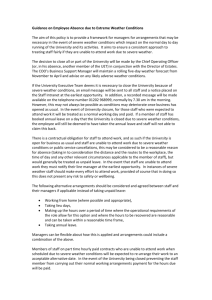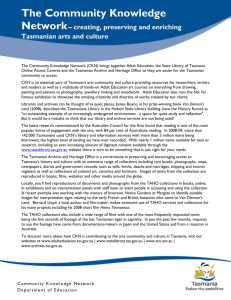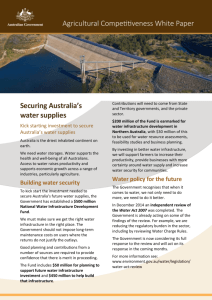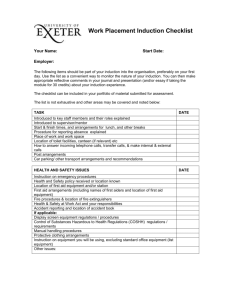WORD - Department of State Growth
advertisement
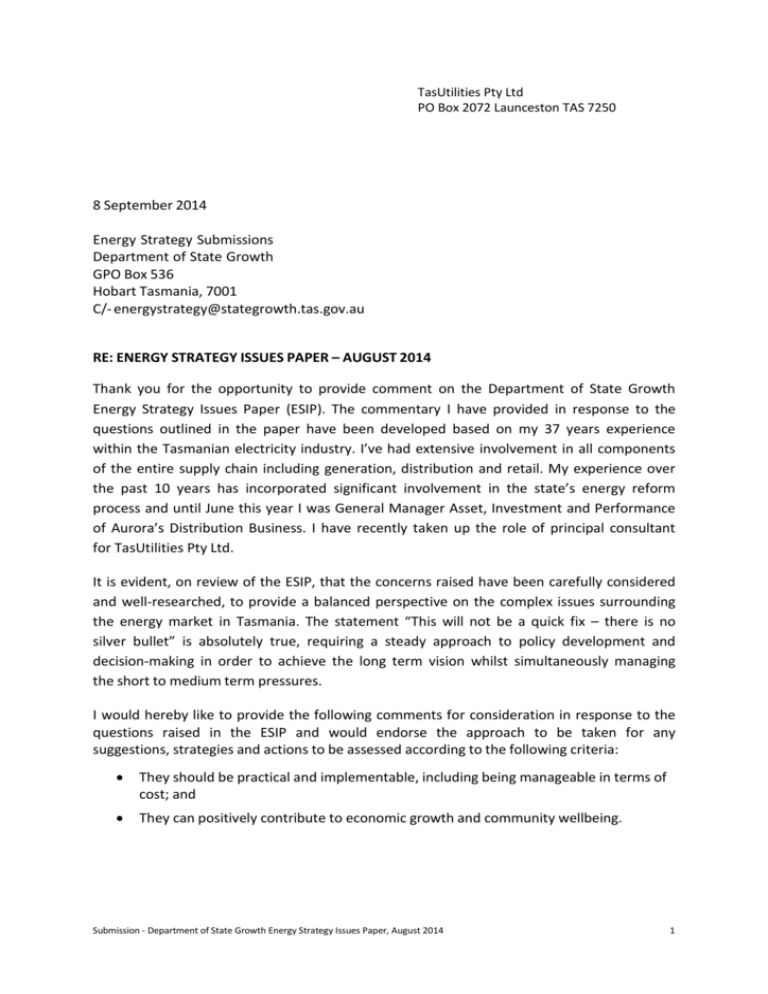
TasUtilities Pty Ltd PO Box 2072 Launceston TAS 7250 8 September 2014 Energy Strategy Submissions Department of State Growth GPO Box 536 Hobart Tasmania, 7001 C/- energystrategy@stategrowth.tas.gov.au RE: ENERGY STRATEGY ISSUES PAPER – AUGUST 2014 Thank you for the opportunity to provide comment on the Department of State Growth Energy Strategy Issues Paper (ESIP). The commentary I have provided in response to the questions outlined in the paper have been developed based on my 37 years experience within the Tasmanian electricity industry. I’ve had extensive involvement in all components of the entire supply chain including generation, distribution and retail. My experience over the past 10 years has incorporated significant involvement in the state’s energy reform process and until June this year I was General Manager Asset, Investment and Performance of Aurora’s Distribution Business. I have recently taken up the role of principal consultant for TasUtilities Pty Ltd. It is evident, on review of the ESIP, that the concerns raised have been carefully considered and well-researched, to provide a balanced perspective on the complex issues surrounding the energy market in Tasmania. The statement “This will not be a quick fix – there is no silver bullet” is absolutely true, requiring a steady approach to policy development and decision-making in order to achieve the long term vision whilst simultaneously managing the short to medium term pressures. I would hereby like to provide the following comments for consideration in response to the questions raised in the ESIP and would endorse the approach to be taken for any suggestions, strategies and actions to be assessed according to the following criteria: They should be practical and implementable, including being manageable in terms of cost; and They can positively contribute to economic growth and community wellbeing. Submission - Department of State Growth Energy Strategy Issues Paper, August 2014 1 Question 1 - What enhancements could be made to regulatory frameworks to ensure the right incentives for businesses and consumers are in place? Having the right regulatory framework in Tasmania is critical, considering most of the market is regulated from wholesale energy products, network activity (both transmission and distribution) and retail standing offer prices. Such regulatory arrangements are appropriate, on the basis Tasmania is too small to provide size and depth to facilitate a competitive market environment. The question for the Government is what are the right measures and criteria to evaluate the effectiveness of these regulatory arrangements? From what has been observed across Australia is recent years, regulation can provide the wrong incentive resulting in unintended consequences such as networks increasing their asset base resulting in higher costs for the customer. At a jurisdiction and national level the regulatory framework for electricity has changed dramatically in recent years with a continuous stream of reviews and consultation. To some degree this has resulted in better protection for consumers and smaller market participants, whilst setting the right performance incentives for network business regarding reliability and operating costs. New changes will also include incentives around capital expenditure. These arrangements are all good, however to provide the right incentives for businesses and consumers you need regulatory certainty and a price path to create the confidence that will lead to economic development. To facilitate this, and without creating a regulatory burden that comes at a cost, the Government should monitor the performance of the current regulatory framework and evaluate against clear objectives for the state. Question 2 - Given both the State and Commonwealth Government are committed to reducing red and green tape, and that the electricity market is highly regulated and complex, what opportunities are there to reduce or remove regulation? It is important to get the balance right to ensure the regulatory framework achieves its objectives without creating an unnecessary regulatory burden on market participants. As stated in the previous question this framework should be reviewed on a continuous basis to ensure the right outcomes are being achieved. For example, the newly introduced obligations for network businesses around National Energy Customer Framework (NECF) & Regulatory Information Notice (RIN) are both important regulatory initiatives aimed at protecting customer rights and providing greater transparency around network costs. It is unclear whether customers were asked what service standard obligations they would like to see implemented and exactly what can customers derive from the volumes of publicly available information pertaining to network businesses. Without a doubt the intention is clearly to provide greater transparency and benchmarking between network companies and jurisdictions. However, because of differences with topography, infrastructure and customer numbers, in most cases, it will be difficult to draw Submission - Department of State Growth Energy Strategy Issues Paper, August 2014 2 any comparison. Nevertheless, one constant that remains is the obligations placed on network businesses to administer such arrangements are very costly and customers will pay more in their tariffs as a result. To limit over regulation, the AEMC needs to work with AER and market participants to establish meaningful and practical reporting requirements. The first logical step would be to work with information that is currently available and then set a framework for incremental improvements over coming years. This would minimise costs whilst allowing time to determine the value to the market of information being captured. Another regulatory reform initiative under development is the ‘Power of Choice’ of which one element will allow competition in metering services. This will also result in cost increases for network and retail businesses to implement. Therefore a robust cost benefit analysis should be undertaken and carefully consideration, particularly for Tasmania, before processing. The irony of the current regulatory framework to provide greater scrutiny and reporting transparency is that regulation is at risk of becoming the new “Gold Plating”, if not managed carefully. The Department of State Growth should work through the Standing Council on Energy & Resources (SCER) as the appropriate body to pursue improvements in transparency and reporting arrangements to establish the necessary regulatory framework for Tasmania at minimal cost to customers. Question 3 - Is retail competition important because of price, choice or for other reasons? The only real benefit to introducing retail competition in Tasmania is to provide consumer choice, given the opportunity for any real cost savings is limited. As highlighted in the ESIP, retailers only have control over 13.1% of regulated tariff costs, with the remaining component determined by generation and networks. The opportunity for a retailer to win customers would require either a cut to its already small margin or the bundling of any price signal from generation and network to match specific customer requirements. Undoubtedly, the real issue for Government remains its ownership of retail in Tasmania. Despite the capabilities of Aurora Retail, led by a highly-effective management team, coupled with the separation of the business from distribution culminating in a refined focus, the fundamentals have not changed. That is, the limited customer base in Tasmania remains impacted by a likely decline with FRC (previously 100% of residential customer), incumbent retail (left with the less profitable customers), small margins, fixed operating costs and the usual market and credit risks associated with retailing. As the Government’s intention is to sell the business at an appropriate time in the future, every opportunity should be explored in the meantime, to help establish a successful business capable of being sold as a going concern. Submission - Department of State Growth Energy Strategy Issues Paper, August 2014 3 Question 4 - What enhancements or additional information could increase the reporting transparency of the Government’s electricity businesses and contribute to improved efficiency? In a fully competitive market that has size and depth, market participants will focus on innovation and operating efficiencies to retain and win additional market share. Without competition there is no downward pressure on prices and responsibility falls back on the regulatory framework to provide the necessary constraints. As the owner of the state’s electricity businesses, the Tasmanian Government therefore needs to be comfortable that the right market pressures are at play to ensure an efficient and sustainable business exist to serve the Tasmanian community. As a consequence, the reporting and transparency needs to be appropriate to provide such reassurance without being over burdensome. The Government could set its expectations through guiding principles and performance targets to achieve the same outcome. At a high-level these should cover service level obligations, return on equity and future price path in line with CPI. Any variation to these parameters would need to be justified and approved or absorbed by the business. Even with generation linked to the Victorian spot market and networks on a five year pricing determination framework there are still enough levers available to ensure a smooth price path mechanism. Dividends to Government from the State Owned Energy Businesses (SOEB’s) over the past 10 years have been volatile, potentially as a result of windfall gains, but underneath all this there still needs to be clear evidence of continuous efficiency improvements to put downward pressure on prices. Both transmission and distribution have both seen considerable investment against forecasted load that has not eventuated and so a period of consolidation is now required. In addition, the amalgamation of the two network businesses into a single business that now represents 58.9% of regulated customer tariffs, means there is potential for cost reductions by leveraging synergies as identified in Expert Panel and PWC reports. Such cost reduction opportunities should explore and evaluate capital expenditure risk assessments, unserved energy contingency arrangements, load forecasting projections, asset boundary review, cost recovery arrangements and innovation with new technologies. A review of performance objectives for the SOEB’s, including price path projections would help provide assurance of downward pressure on customer prices. There is also a role for Government to be assured the cost of amalgamating the network businesses is offset by long term savings and greater efficiency. Question 5 - Do energy intensive and trade exposed businesses require greater future price certainty to maintain and/or grow their operations? Future price certainty is likely to be beneficial to all business customers, but particularly those where energy costs make up a key component of their total input costs. This would prove valuable in budgeting and subsequently assist in providing a degree of confidence in investment and expansion decisions. This should be a key objective of the Government to remove as many variables as possible driving price volatility. The creation of a healthy Submission - Department of State Growth Energy Strategy Issues Paper, August 2014 4 business environment through policy decisions is far more cost effective than subsidising businesses to continue to operate once they get into difficulty. Ultimately, it’s about proactively influencing the factors that are within the SOEB’s control. This matter just highlights the need to work in partnership with SCER to develop an appropriate regulatory framework including a suitable cost recovery mechanism for network businesses. This issue will be considered at a national level as part of network tariff reforms to move to more cost-reflective pricing structures. Question 6 - Would you consider accepting slightly lower levels of reliability if this resulted in materially lower prices? Getting the right balance between reliability and price can be problematic, dependent on specific customer circumstances and to a large degree the weather. Consequently, there needs to be far greater community consultation to ensure a better understanding of limitations and drivers. What might be perceived as an acceptable reliability standard can vary dramatically depending on recent experience or individual customer requirements. For example, a short-term interruption during the night can be extremely inconvenient to a farmer who is trying to irrigate crops, in contrast to residential or business customers who may only need to reset their digital clocks the next morning. Despite reliability requirements being very customer specific, network configurations mean the ability to segregate standards is limited as all customers in a common area will be affected. As a result, reliability standards are usually classified by terrain or communities. These standards are measured by the number of events and by the time that supply was off. To maintain reliability standard set by the Regulator, network businesses provide contingency arrangements through automation and by building redundancy or protection into the network, which all comes at a cost. Also because current pricing arrangements are based on postage stamp methodology, slightly lower levels in reliability will take a number of years for savings to flow through, which are then apportioned across all customers and not just customers accepting the lower standard. Alternative arrangements could be considered such as after hour callouts or arrangements on dedicated lines to specific customer groups. However, network tariff arrangements would need to change to ensure cost savings were contributed to the customers accepting the lower standard. At a national level SCER has agreed to the development of a national reliability framework to ensure network reliability costs are efficiency based and reflective of the customers’ willingness to pay. The Energy Network Association (ENA) in its submission to the Energy White Paper gave support to a national framework that ensures: - Reliability spending is efficient and provides a level of reliability that customers value; Customers are engaged in the process for determining reliability spending in a meaningful and timely manner; There is independent oversight of the way that network reliability standards and targets are set, while a continuing customer relationship with networks is maintained; and Submission - Department of State Growth Energy Strategy Issues Paper, August 2014 5 - There is flexibility and incentives for networks to innovate to improve customer outcomes. Regardless of the outcome of any such review, it is extremely important that any strategy or policy position encourages the facilitation of new technology to allow customers to set their own reliability requirements. This would allow the network provider to offer only the base level requirements at the most cost effective price. Customers could then use storage or uninterrupted power supply systems to meet their own specific needs. For example, as the technology associated with electric vehicles evolves, a customer in the future could use offpeak energy to charge the vehicle, but use the stored energy in the vehicle during an outage to supply essential services within the home such as the fridge, lighting and internet. Revisiting the original question, for customers to accept slightly lower levels of reliability, resulting in materially lower prices is unlikely to be achieved in the short term and without changes to the tariff pricing structure. Question 7 - Would a review of tariff structures be desirable, in terms of minimising total network costs and allocating costs fairly? A review of tariff structures is long overdue and like the reliability framework, an integrated suite of network tariff reforms is high on the agenda of priorities for SCER to consider. This review includes a shift to more cost reflective and time varying pricing. There is widespread acknowledgement, including supporting commentary contained within the Federal Government’s Energy White Paper – Issues Paper December 2013, indicating that trends in technology and consumer choices means current network tariff structures are generally unsustainable. This is primarily because under retail tariffs, network cost recovery is usually based on energy consumption, with a relatively small fixed charge component, when in effect distribution network costs are actually largely fixed. As a result, and as highlighted in the ENA submission to the Energy White Paper, this lack of accurate cost-reflectivity can result in inefficient customer investment decisions with cost shifting between customers. This ‘hidden transfers’ between different customers, is likely to only increase with greater take up of solar PV cells and use of other new technologies. In addition, current market rules could also facilitate ‘hidden transfers’ at the transmission level, particularly in Tasmania. That said, a tariff structure review will not reduce total network costs, but rather, provide a fairer allocation on how the network is being used. This explains why network businesses are promoting a shift away from consumption pricing in favour of more capacity or demand structured charging. This way customers effectively have the minimum network cost relating to their requirements. To reduce actual network charges then the key driver needs to be operational efficiency, reliability standards and greater utilisation of the network through load shifting. There is no doubt that embedded generation, energy storage, smart grid technologies and electric vehicles will play a role in reshaping the way that electricity is supplied and consumed, presenting with it a range of additional challenges and opportunities. Submission - Department of State Growth Energy Strategy Issues Paper, August 2014 6 With regard to customer contributions for augmentation and connection works, some of which is already contestable, these could be expanded if construction crews are authorised to undertake the work. Costs are also recovered in an upfront customer contribution and other elements within tariffs. Variations to these arrangements could always be reviewed, but the danger in shifting to tariff only recovery, based on consumption levels that may not be realised, will mean that the broader customer base will pay for the upgrade work. To address this and to minimise upfront cost, a solution may be to have customers enter into fixed payment arrangements in addition to tariff charges. Pricing arrangements can be extremely complex. The main focus above has been on the network component leaving energy generation and the retail components, which may present different pricing issues. All of these issues will no doubt be debated as part of SCER’s network tariff restructure reforms, however, there is merit in identifying and resolving specific Tasmanian pricing issues and barriers restricting economic development in the state. Question 8 - What approach, including non-regulatory ones, should Government consider for improving the thermal efficiency of our buildings? The biggest and most effective approach to encourage energy efficiency is behavioural change; that is, empowering customers to seek out efficient appliances and home improvements regarding thermal efficiency. Efficient and transparent pricing is also a key element to secure optimal energy efficiency. There is evidence that recent price rises are a contributing factor in the unprecedented falling demand for electricity across Australia over the past few years. Effort should focus on identifying and removing barriers restricting efficient operation of the market. Then new appliances and building standards can be effective in delivering greater energy efficiency if the information is readily available to customers to enable them to make informed decisions. The only potential risk is ensuring that any investment in energy efficiency solutions does not distort the market, resulting in energy costs increasing to other consumers as a consequence. Hence, network tariff reforms are so important. Question 9 - What approach to energy efficiency should Government use to help improve productivity for small to medium businesses, and to reduce energy bills for households? As stated above, there would appear to be plenty of information and various programs to assist customers to reduce their energy bills. However, retailers and energy advisors could provide energy efficiency advice as a point of differentiation to win customers through bundled solutions. As highlighted in the ESIP there could be reluctance from customers to action energy efficient measures due to upfront costs, although this could be addressed by retailers. For example, the telecommunications industry provides bundled solutions with mobile phone plans requiring zero upfront cost. Submission - Department of State Growth Energy Strategy Issues Paper, August 2014 7 Question 10 - What role should Government play in attempting to retain and increase load growth in Tasmania and how should it do it? Without any doubt spare energy capacity exists within Tasmania which should be used to both facilitate economic growth from existing Tasmanian businesses and attract new businesses. This doesn’t need to be energy intensive customers, but instead small to medium businesses that can leverage off Tasmania’s clean green image such as agriculture and tourism. Ideally, such opportunities should occur in conjunction with spare infrastructure capacity, allowing higher utilisation of exiting assets to provide a lower effective energy price for all customers. This approach would require co-operation from all stakeholders, with the necessary arrangements facilitated by the Government. The outcome could be reduced rates, based on ‘short run marginal cost’ for an initial period of time with specific criteria to generate economic activity and create sustainable employment. These programs would be open to new and existing customers subject to meeting the criteria guidelines and as this activity would not have otherwise occurred, there should be no impact to Government dividends from the SOEB’s. The alternative will be underutilised assets and resources resulting in a downward spiral for the state, creating upward pressure on energy costs for existing customers. Some industry observers would remember the supply issues in mid-2000 due to hydrological risk from the state’s predominant hydro generation, although this has since been mitigated with the completion of Basslink, natural gas pipeline and the thermal gas turbines at Bell Bay. Hence, any new initiative intended to create economic activity in the short term through attractive energy rates should not create future supply issues for the state. The Government needs to establish the right framework for SOEB’s to make sound business decisions, equally conscious that any such decisions need to be in the best interests of the Tasmanian community as a whole. Question 11 - What further potential is there to develop renewable energy in Tasmania, including wind energy, given there is no unmet Tasmanian demand requiring additional generation for the foreseeable future? With the Federal Government releasing the Independent Panel Review into Renewable Energy Target (RET) in late August, specifically recommending a winding back or even scrapping parts of the scheme, the outlook for renewables will obviously slow in the short term. The Federal Government is currently considering the findings before announcing its response, which only adds to the uncertainty, even though customer demand and awareness is likely to remain strong. What is not known is the price point that customers are willing to pay. However, like any medicine one might take for the greater good there can also be side effects. Renewables are no different and connection of such devices to the network create problems that the original network has not been designed to manage. This applies to both large and small scale renewables, particularly in Tasmania, where market services or network augmentation to manage such issues result is additional costs to the market that is eventually paid by customers. Submission - Department of State Growth Energy Strategy Issues Paper, August 2014 8 Nevertheless, renewables, battery storage and smart networks will undoubtedly change the way energy and services are delivered to customers in the future. For the time being however, with respect to the current environment, any activity needs careful consideration before proceeding. Question 12 - Is there a further facilitation role for Government in gas roll-out, or should Government focus its efforts on examining the costs and benefits of improving minimum protections for gas customers? Based on current take-up rates and considering the future outlook for gas prices, there is very little justification to facilitate further gas roll-out without achieving significant volume increases. Regarding minimum protection arrangements for gas customers this is no doubt important but at this point in time it remains more of a secondary issue. The bigger issue for concern is the future sustainability of natural gas in the state, which is very much linked around the viability of Tamar Valley Power Station (TVPS) or a new point load to underpin gas transport costs to the state. Natural gas was brought to the state on the back of a large point load in TVPS to underpin infrastructure. In 2012 the power station was consuming 63% of natural gas to the state. Should the power station cease to operate due to the current oversupply of electricity in the state, then transport costs are likely to be spread across the remaining customer base once existing contractual arrangements expire. This has the potential to see the demise of natural gas in the state as an alternative energy source. Therefore the Government needs to determine what needs to be the future strategy for natural gas and what might be the critical initiatives to implement this strategy. Such options could include, securing an alternative point loan, continue to use TVPS and offer competitive electricity price to generate economic activity, test the market for a potential buyer of the power station with transmission assets to operate TVPS as a going concern or leave it to the market to determine. Question 13 - What are considered to be the key opportunities, and the key issues, associated with possible energy futures? The key opportunities and issues associated with possible energy futures have been discussed in this submission and are as follows: Work through the Standing Council on Energy & Resources (SCER) to pursue improvements in transparency and reporting arrangements at minimal cost to customers and evaluate current regulatory framework against state objectives. Review performance objectives for the SOEB’s, including price path projections to be assured of downward pressure on customer prices and that the cost of amalgamating the two network businesses is offset by long term savings and greater efficiency. Submission - Department of State Growth Energy Strategy Issues Paper, August 2014 9 Opportunities exist to facilitate improvements through the Department of State Growth for businesses to expand and/or start up in the state that can leverage off our green/clean image and use surplus energy plus spare capacity in electricity, gas, water, rail and ports infrastructure. Industry and Government departments to work together to establish appropriate arrangements as part of the national network tariff restructure reforms, whilst addressing short-term pricing issues to ensure consistent sustainable pricing to give the market confidence to invest; and Determine what needs to be the future strategy for natural gas in the State and what might be the critical initiatives to implement this strategy. Question 14 - What could be some outcomes for the Tasmanian Energy Strategy, and what actions can government, or energy providers and consumers take to achieve them? How could success/performance be measured? Key outcomes for the Tasmanian Energy Strategy needs to be stable energy price projections, greater efficiency with delivery of services and surplus capacity used to generate economic activity. Appropriate performance measures should be developed around these objectives, with SOEB’s assigned accountability and encouraged to work together to achieve the best outcome for the state. Conclusion Thank you for the opportunity to provide comment to the Energy Strategy Issues Paper. As highlighted above, the issues to be considered are highly complex, with many potential implications for Tasmanian energy consumers. Should you have any queries or require further information regarding any of the issues and opportunities outlined in this submission, please do not hesitate to contact me. Yours sincerely Shaun O’Loughlin Submission - Department of State Growth Energy Strategy Issues Paper, August 2014 10

